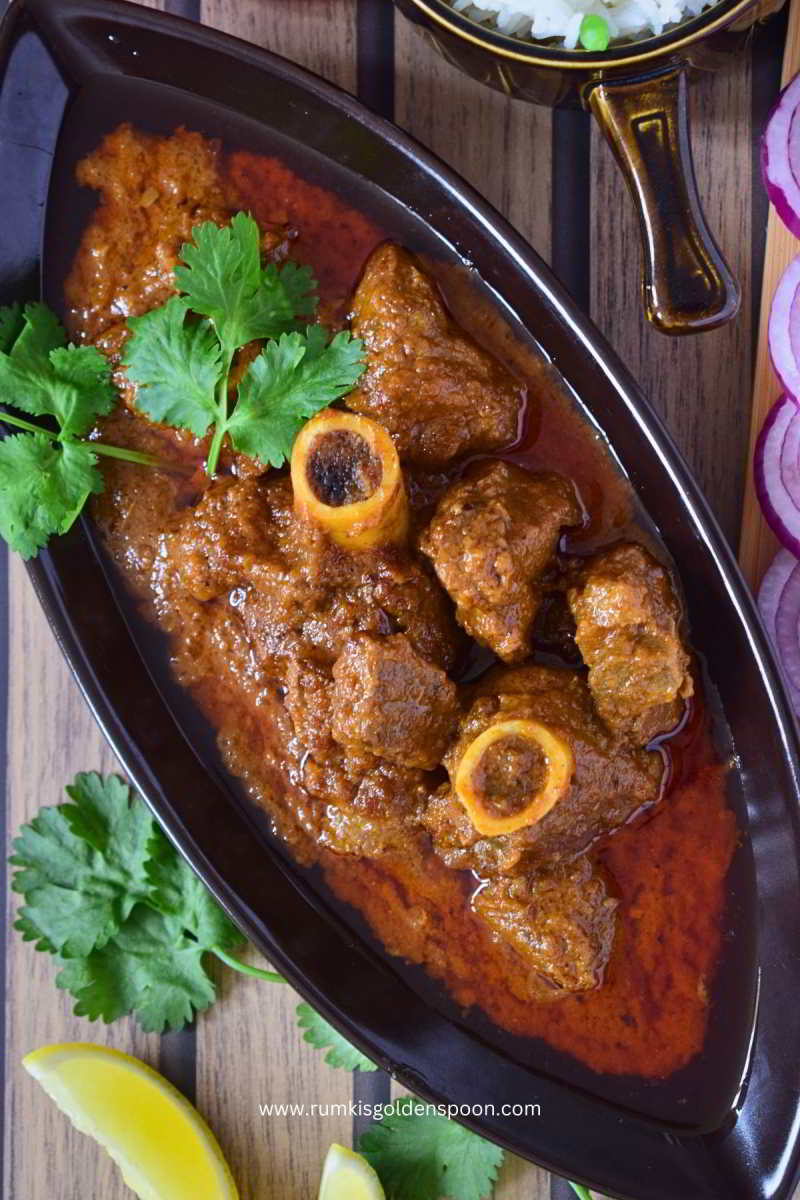Mutton korma aka lamb korma is a scrumptious mutton curry recipe which is crazily popular all over India for its inimitable taste, texture and flavour. It is a rich, creamy, extremely flavoured, slow-cooked mutton curry where tender mutton pieces are cooked in clarified butter aka ghee with fried onion, yogurt, ginger-garlic, cashew-almond paste, kewra water, saffron milk and a few specific whole & ground spices. This inimitable delight is mostly accompanied by rumali roti, butter naan or paratha and even with pulao, plain Basmati rice etc. It could be a perfect addition to your dinner table for any special occasion or get-together.
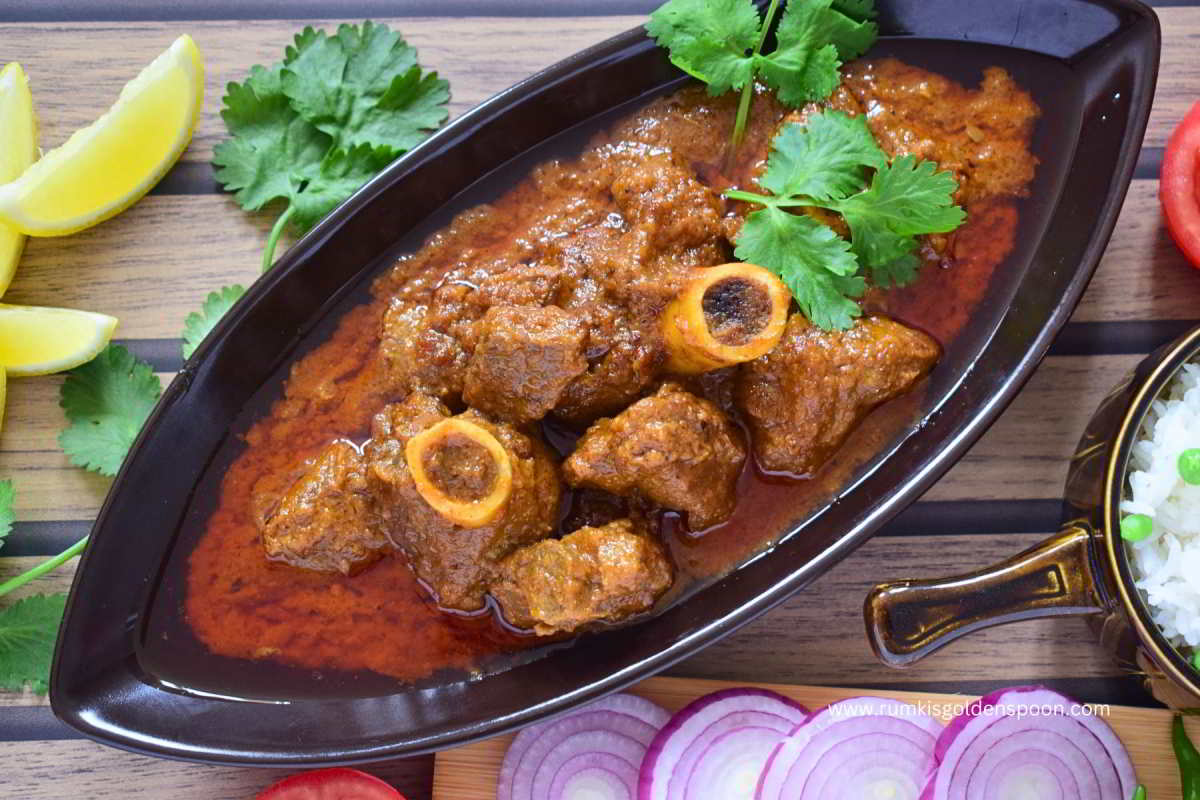
Table of Contents
About the recipe
Tips and Suggestions
Frequently Asked Questions
How to make Mutton Korma (step wise photos)
Recipe Card
What is Mutton Korma?
Mutton korma recipe is a popular mutton recipe that originated in Mughlai cuisine. Traditionally, this dish is prepared with goat or beef. The word korma comes from the Urdu word qorma which means braise. But nowadays, this dish is prepared in different ways in different sub-continents of India. In northern India, lamb korma gravy is prepared with fried onion paste and yogurt and in south India, the mutton korma gravy is prepared with coconut milk.
Though korma means braised but nowadays people prefer to use a pressure cooker or instant pot to prepare the dish faster rather than the traditional slow-cooked method. But I personally highly recommend the traditional method to prepare this classic delight. The slow-cooking process makes the lamb tender, juicy and more flavourful. The juice released from the bones and bone marrows during the slow cooking process makes the gravy taste incredible.
Mutton korma aka korma mutton recipe is a rich, creamy, flavourful and delicious mutton curry recipe where bones-in fresh-cut mutton pieces don’t need to be marinated. In this preparation, mutton pieces are cooked in clarified butter aka ghee with fried onion aka beresta paste, yogurt, ginger-garlic, cashew-almond paste, kewra water, saffron milk and a few specific whole & ground spices. The addition of kewra water and saffron streaks at the final stage uplifts the flavour of the dish to the next level like many other Mughlai dishes. Lamb korma contains moderately thick, luscious gravy which is mostly served with rumali roti, naan, paratha or simply with rice or pulao. This recipe reflects the Mughal Empire’s involvement in India.
Mutton Korma – Reason behind its popularity
- Mutton Korma has occupied a place on the Menu card of almost all non-vegetarian restaurants in India.
- Mutton Korma is known for its inimitable taste and charismatic flavour. The flavoured gravy with the richness of nuts has won the hearts of millions.
- It is one of the most versatile dishes which can be accompanied by any rice items or flatbreads.
- It is a simple dish and is very easy to prepare.
- Mutton korma is less spicy and mildly heaty in taste which makes the dish kids-friendly.
- It’s rich taste and royal flavour makes it suitable for special occasions.
Mutton korma aka lamb korma is one of my favourite mutton curries which I can’t stop myself to devour till my stomach is tightly packed. Anyways Bengalis always prefer mutton over chicken. In fact, I never met any non-vegetarian person in my entire life who does not like the korma mutton recipe.
Mutton Korma recipe is a family favourite dish and each member of my family just loves it crazily. Whenever I talk about the recipe, it brings lots of nostalgia and beautiful memories to my mind. In fact, whenever we visit India, we always make sure to go to a restaurant and order lamb korma with either rumali roti or butter naan and sometimes with biryani to complete the trip delectably.
Mutton korma aka lamb korma is a very simple lamb curry recipe and the difficulty level of cooking this recipe is medium. The ingredients required to prepare the dish are easily available in any Indian kitchen pantry. It is a slow-cooking recipe where the mutton pieces melt in the mouth. So it can’t be cooked in hurry.
Advantages to preparing Mutton Korma at home
There is no doubt in it that Mutton Korma is a super rich dish and it is always become a part of the dinner menu for special occasions and not for regular eating. But if you prepare this scrumptious dish at home then you will have full control to make it less rich.
You can also manipulate the amount of ghee, cashew nuts and red chillies to be added to the gravy according to your choice without compromising the taste of the mutton korma recipe.
Ingredients for Mutton Korma
Red meat: Traditional mutton korma is prepared with goat meat but can be replaced with lamb too. Red meat takes longer to get cooked, so I don’t suggest chicken for the recipe. The taste and texture of red meat cannot be substituted with chicken.
Fried onion aka beresta paste: It is one of the most important ingredients used to flavour up the dish and to provide texture.
Ginger-Garlic: These are the most common ingredients used to provide taste and to flavour up the curry.
Cashew-Almond paste: It is one of the important ingredients of the recipe which provides richness, creaminess, nutty flavour and an irresistible taste to the dish.
Yogurt: It is another very important ingredient which adds a mild tangy taste to the gravy and enhances the flavour of the dish.
Whole spices: I have used cinnamon sticks, green cardamoms, black cardamom, cloves, bay leaf and star anise for tempering. All the spices induce a nice flavour to the dish.
Ground spice mix: I always prefer to prepare homemade fresh spice mix before preparing mutton korma for maximum flavour. In this spice mix, I have used cinnamon sticks, green cardamoms, black cardamom, cloves, black peppercorns, dried Kashmiri red chilli, javitri aka mace and nutmeg. First, slightly dry roast the whole spices and then grinds them to dust.
Kashmiri red chilli powder: Mutton korma is mildly heaty in taste. The addition of red chilli powder adds nice colour and a slightly heaty taste to the dish.
Kewra water and Saffron milk: I used kewra water and saffron milk at the final stage of cooking the recipe. Each element plays a vital role in flavouring up the curry.
Salt: It provides a basic taste; I mean salty taste to the curry.
Water: It is used to adjust the consistency of the gravy.
Oil & Ghee: I have used both ghee and oil for the recipe. Any cooking oil can be used to fry the onions. I have used olive oil, but you can also use flavourless oil like vegetable oil, sunflower oil, rapeseed oil etc. I have used ghee to cook the mutton korma. It gives a better taste and flavour to the dish.
Mutton Korma recipe step by step with pictures and instructions have been provided in the ‘Instructions’ section of the recipe. I have included all the tips and tricks to make the recipe easier for you. If you follow the recipe step by step, then you will surely get the perfect results.
Tips to prepare perfect Mutton Korma
- Try to prepare mutton korma recipe with medium size bone-in pieces for better texture. Always use fresh-cut mutton for the best texture.
- For a traditional mutton korma recipe, it does not need to be marinated. Please follow the same, it won’t smell bad.
- Fried onions are the most important part of the recipe which cannot be compromised. The addition of fried golden brown onion paste is a must. Don’t skip it.
- Always use homemade fresh ginger-garlic paste for the recipe rather than readymade ones for a more intense flavour.
- Please prepare a freshly ground spice mix before taking a preparation of mutton korma. Trust me, it gives a thousand times better result than readymade masala.
- Don’t skip the paste of cashew nuts and almonds from the recipe. It provides nutty flavour, richness and creaminess to the gravy.
- Cook the recipe in ghee aka clarified butter for the best flavour and taste. If you are health conscious then can use the combination of oil and ghee to reduce the amount of ghee.
- The whole spices induce a nice flavour to the dish. Don’t skip it.
- Don’t skip kewra water and saffron milk from the curry. It gives authentic Mughlai flavour to the dish.
- Be patient and slow-cook the mutton till tender and juicy. Stir in between at regular intervals.
Frequently asked Questions
Can I use a pressure cooker to prepare mutton korma?
It is tough to answer just by saying the word yes or no. It can be prepared in a pressure cooker, but the taste and flavour won’t be the same which comes from slow cooking. So, I recommend not using a pressure cooker for the classic recipe.
Can I skip cashew-almond paste from the recipe?
Yes, you can. The addition of cashew-almond paste provides creaminess and nutty flavour to the dish.
Can I cook mutton korma in oil instead of ghee?
Yes, you can cook it in oil. But you have to compromise on the taste and flavour of the dish. If you are health conscious then I can suggest you use the combination of both oil and ghee to reduce the amount of ghee.
Can I use readymade spice mix instead of homemade masala?
Yes, of course. But the homemade masala gives maximum flavour to the dish.
How to eat mutton korma?
Mutton korma aka lamb korma is a richly flavoured and utterly scrumptious recipe which can get fitted very easily with myriad sides. In my opinion, it is one of the most versatile mutton curry recipes which can be accompanied by rumali roti, butter naan or paratha and even with pulao, plain Basmati rice, jeera rice or Biryani etc.
Can I use other meat for the mutton korma recipe?
Yes, you can try lamb instead of goat meat following the same recipe and other ingredients. If you want to use chicken then the cooking time will reduce.
Can I use chicken for the recipe?
Mutton korma is prepared with goat or lamb meat which is red meat and we all know red meat takes longer to get cooked. Chicken korma can be prepared using this recipe, but it will get cooked much earlier than red meat. So, you need to keep your eyes on it.
How can I prepare a vegetarian version of mutton korma?
Green jackfruit is the best option for the vegetarian version of it. Cauliflower or soya chunks can also be used for the vegetarian version.
How to make Mutton Korma?
To prepare the mutton korma, first, you need to prepare the spice mix. Put a dry pan on flame and dry roast the whole spices black cardamom, green cardamom, cloves, cinnamon sticks, black pepper, dried Kashmiri red chilli, mace and nutmeg. Then transfer them to a separate dry plate and allow them to cool down completely before grinding. Transfer the whole spices to a small jar of a grinder and pulse it till smooth in texture. You can prepare the masala in advance and store it in an airtight container in a cool and dry place away from sunlight for 3-4 months.
Take warm milk into a bowl and add saffron to it. Soak the saffron in the milk at least for 20 minutes so that it can release flavour and colour to the milk.
Take a bowl and add cashew nuts and almonds into it. Add hot water to it and allow it to soak for 10 minutes. Take a jar of a grinder and transfer cashew and almonds into it. Add some water and close the lid of the jar. Pulse it to a smooth paste. Keep the paste aside.
Then make a separate paste of ginger and garlic. Add small ginger cubes and peeled garlic cloves into a jar of a grinder and add some water if required. Close the lid of the jar and pulse it to a smooth paste and keep it aside.
Next, wash the mutton pieces nicely and keep them aside.
Now, it’s time to prepare the beresta aka crispy fried onions. For this, cut thin slices of the onions evenly and separate them with your hands. Now take a pan and add enough oil to it. Once the oil is hot, add onion slices and fry it over medium flame till crispy and golden in colour. Then strain the beresta properly and transfer them to a separate plate. Don’t overcrowd the pan during the time of preparing beresta and stir it continuously. Allow the beresta to cool down completely and then transfer it to a jar of a grinder. Pulse it to a paste and keep it aside.
Now, in the same pan, add some ghee aka clarified butter and put it on medium flame. Once the ghee melts, add the whole spices – cinnamon stick, green cardamoms, black cardamom, cloves, star anise, bay leaves and allow them to crackle.
Add the washed mutton pieces into the pan and give a nice stir. Fry the mutton pieces over medium-high flame for 7-8 minutes until the colour of the mutton pieces changes. Stir it continuously for even cooking.
Then add the freshly ground ginger-garlic paste into the pan and mix it thoroughly. Turn the flame to medium-low and cook it for 12-15 minutes. Stir it frequently at regular intervals.
Now, add whipped yogurt at room temperature into the pan. Add red chilli powder, salt and mix all the ingredients well. Cook it over medium flame for around 12-15 minutes until the oil gets separated. Stir it at every 5 minutes interval.
Then add 4 cups of water and cook it over a high flame until the water starts boiling. Then turn the flame to low and cover the pan. Cook it for 60-90 minutes until the mutton pieces get tender. The cooking time may vary due to the quality or quantity of mutton.
Then add the grind beresta aka fried onion, cashew-almond paste, freshly ground spice mix one by one into the pan and mix it well. Cover the pan and cook it over low flame for another 10-15 minutes.
Take off the lid of the pan and check the consistency of the gravy. If you want more gravy then add ⅓-½ cup of water and turn the flame high to allow it to boil. Check the salt of the gravy and add more if required.
At the final stage, add kewra water and saffron-soaked milk, one by one into the pan and mix it well. Cook it on high flame for 10-15 seconds and then switch off the flame. Now the mutton korma is ready to serve.
Many non-vegetarian recipes have already been shared in my previous posts. You can check a few of them like
Mutton Kosha
Chicken Rezala
Chicken Bharta
Kolkata Chicken Biryani
..And Many more…
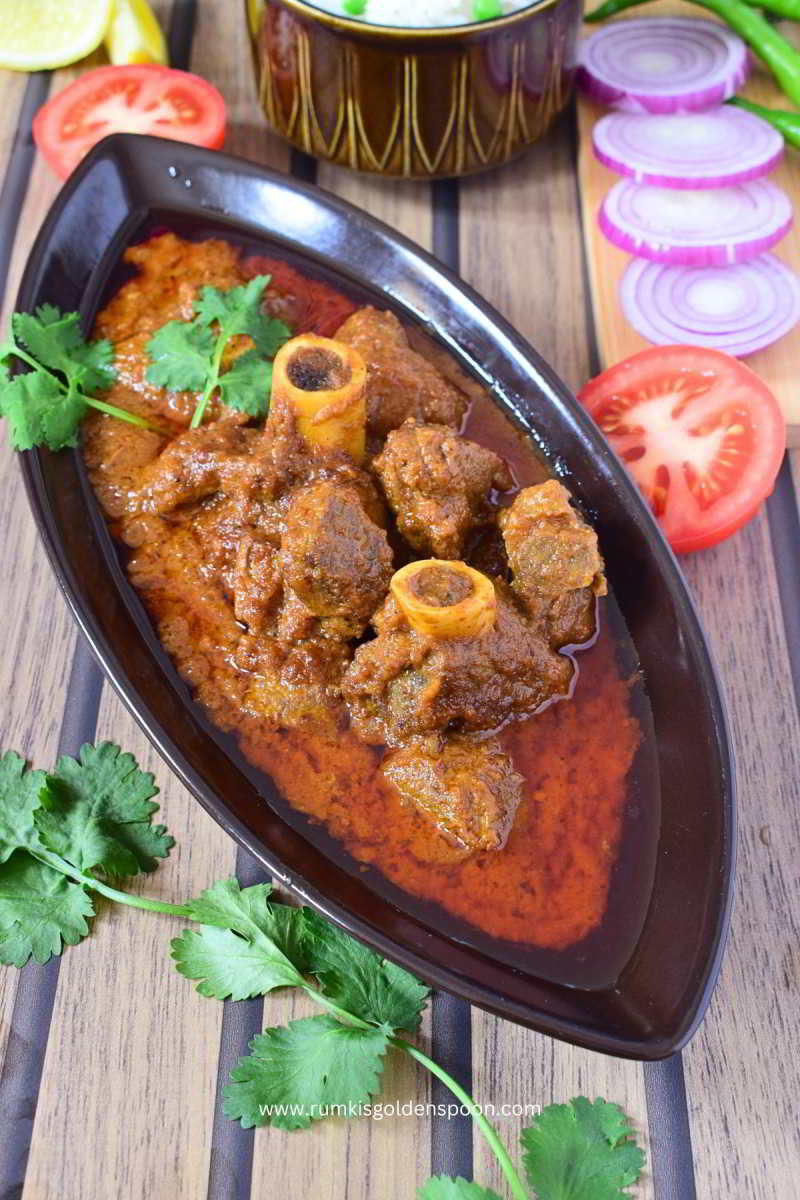
Ingredients:
1 cup = 250 ml
To prepare the spice mix
- 5 green Cardamoms (choti Elaichi)
- 1 black Cardamom (badi Elaichi)
- 2 inches Cinnamon stick (Dalchini)
- 4 Cloves (Laung)
- ½ Mace (Javitri)
- ¼ Nutmegs (Jaiphal)
- 1 dry Kashmiri red Chilli (Kashmiri Lal mirch)
- ½ teaspoon Black peppercorns (Kali mirch)
For the cashew-almond paste
- 5 Cashew nuts
- 5 Almonds
- 2 tablespoons Water
For the saffron milk
- 1 pinch Saffron (Kesar)
- 2 tablespoons warm Milk
For the beresta or barista
- 5 large Onions, thin sliced
- ¼ cup Vegetable oil or any other odourless Oil
For the curry
- 1 kg Mutton, bone in curry cut
- 1 cup fresh and thick Yogurt
- 3 tablespoon Garlic paste or 10-12 large garlic cloves
- 2 tablespoon Ginger paste or 2 inches Ginger
- 3 Bay leaves (Tejpatta)
- 7-8 Green Cardamoms (choti Elaichi)
- 1 Black cardamom (badi Elaichi)
- 3 inches Cinnamon stick (Dalchini)
- 10 Cloves (Laung)
- 1 Star Anise (Chakra Phool)
- 1 teaspoon Kashmiri red chilli powder
- 1½ tablespoons Kewra water
- 4 cups Water for gravy (adjust according to your desired consistency)
- Salt to taste
- ¼ cup Ghee aka clarified butter for cooking
Instructions:
For the spice mix
- Put a dry pan on flame and allow it to become completely dry. Add the whole spices – 1 black cardamom, 5 green cardamom, 4 cloves, 2 inches cinnamon sticks, ½ teaspoon black pepper, 1 dried Kashmiri red chilli, ½ mace and ¼th nutmeg, one by one into the pan. Dry roast them over medium flame for 2-3 minutes until a nice aroma comes out of the spices. Then transfer them to a separate dry plate and allow them to cool down completely before grinding.

- Take the whole spices into a small jar of a grinder and pulse it to a smooth dust-like texture. Note: You can prepare the masala in advance and store it in an airtight container in a cool and dry place away from sunlight for 3-4 months.
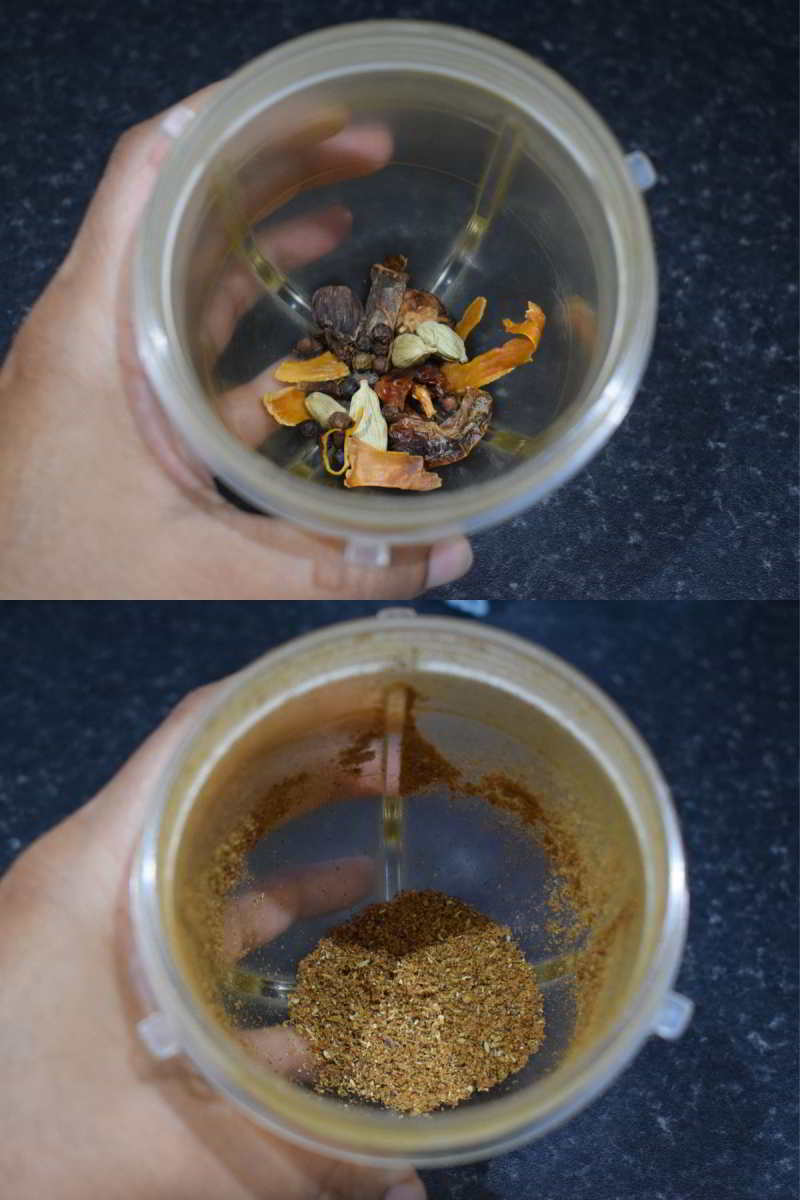
For the beresta or barista
- Thin slice 4 large onions evenly and separate them with hands.
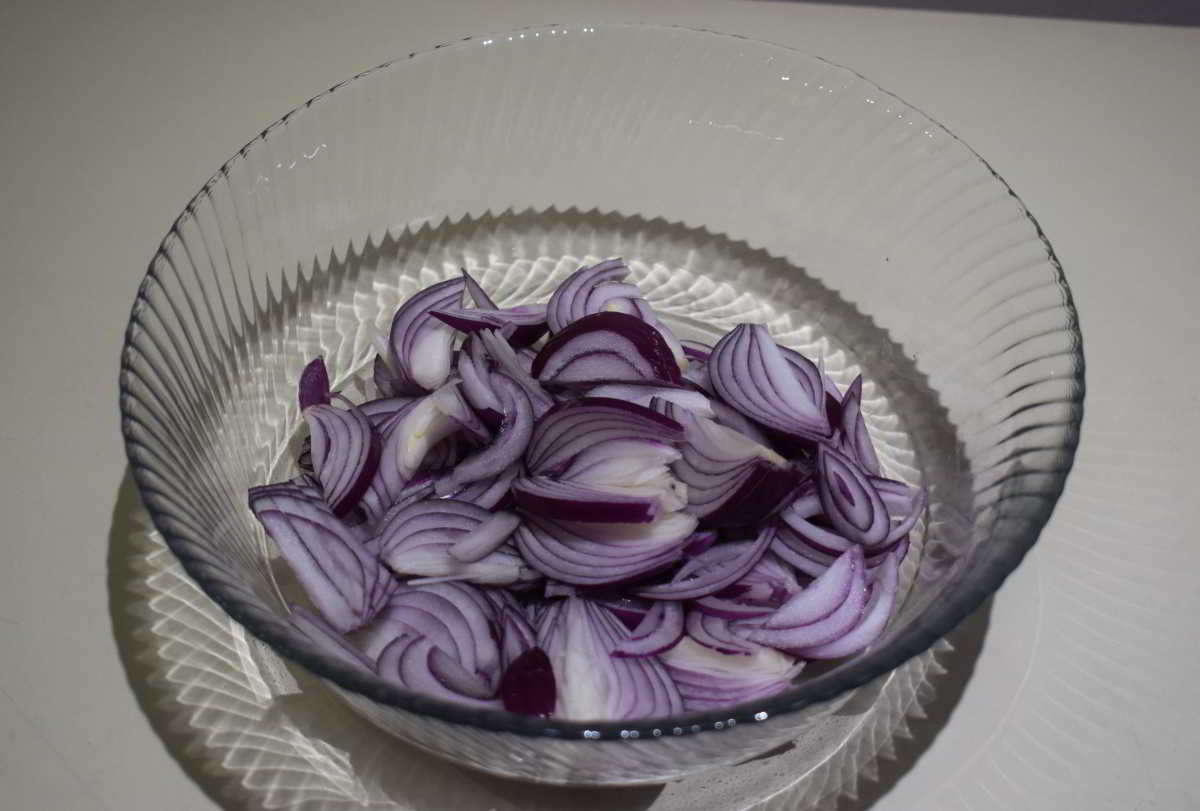
- Now, put a pan on flame and add ¼ cup oil to it. Once the oil is hot, add onion slices and fry it over medium flame till crispy and golden in colour. Then strain the beresta properly and transfer them to a tissue-lined separate plate. Don’t overcrowd the pan during the time of preparing beresta and stir it continuously or else it will not get fried evenly.
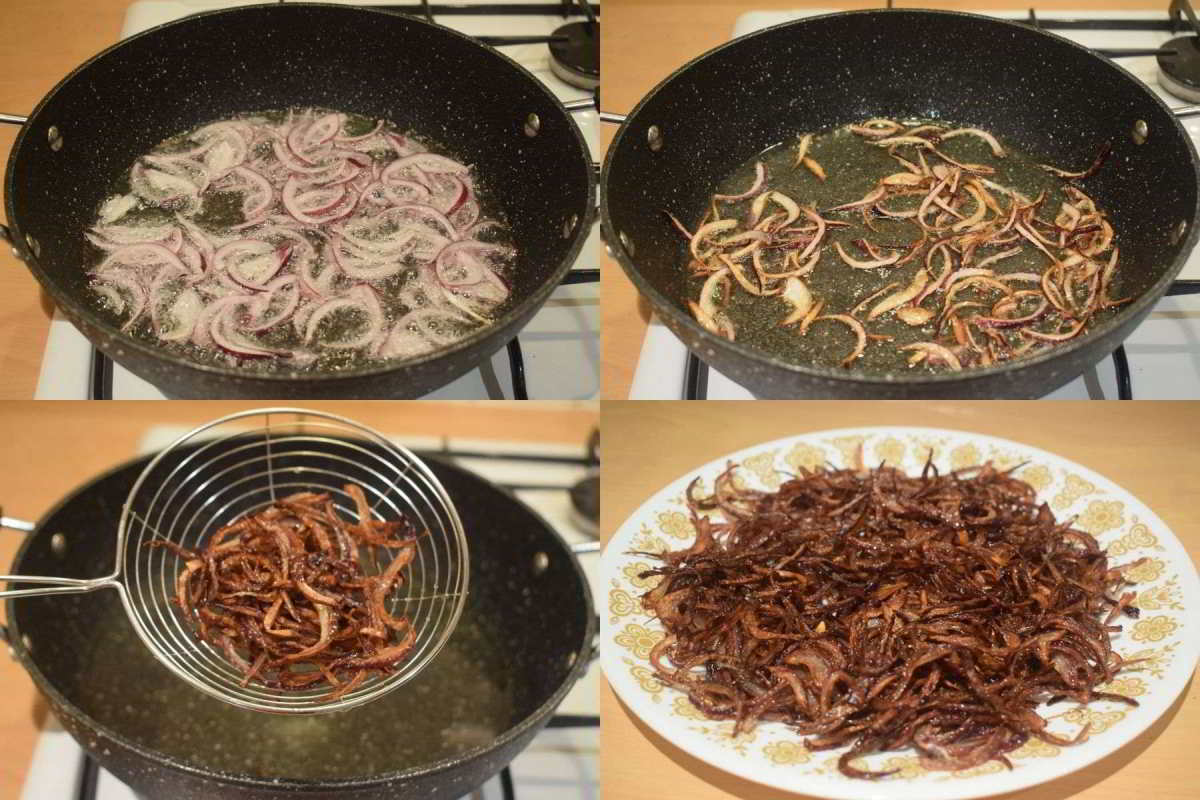
- Allow the beresta to cool down completely and then transfer it to a jar of a grinder. Pulse it for a minute and keep it aside.

For the curry
- Take 2 tablespoons of warm milk into a bowl and add a pinch of saffron to it. Soak the saffron in the milk at least for 20 minutes so that it can release flavour and colour to the milk.

- Take a bowl and add 5 cashew nuts and 5 almonds into it. Add hot water to it and allow it to soak for 10 minutes.
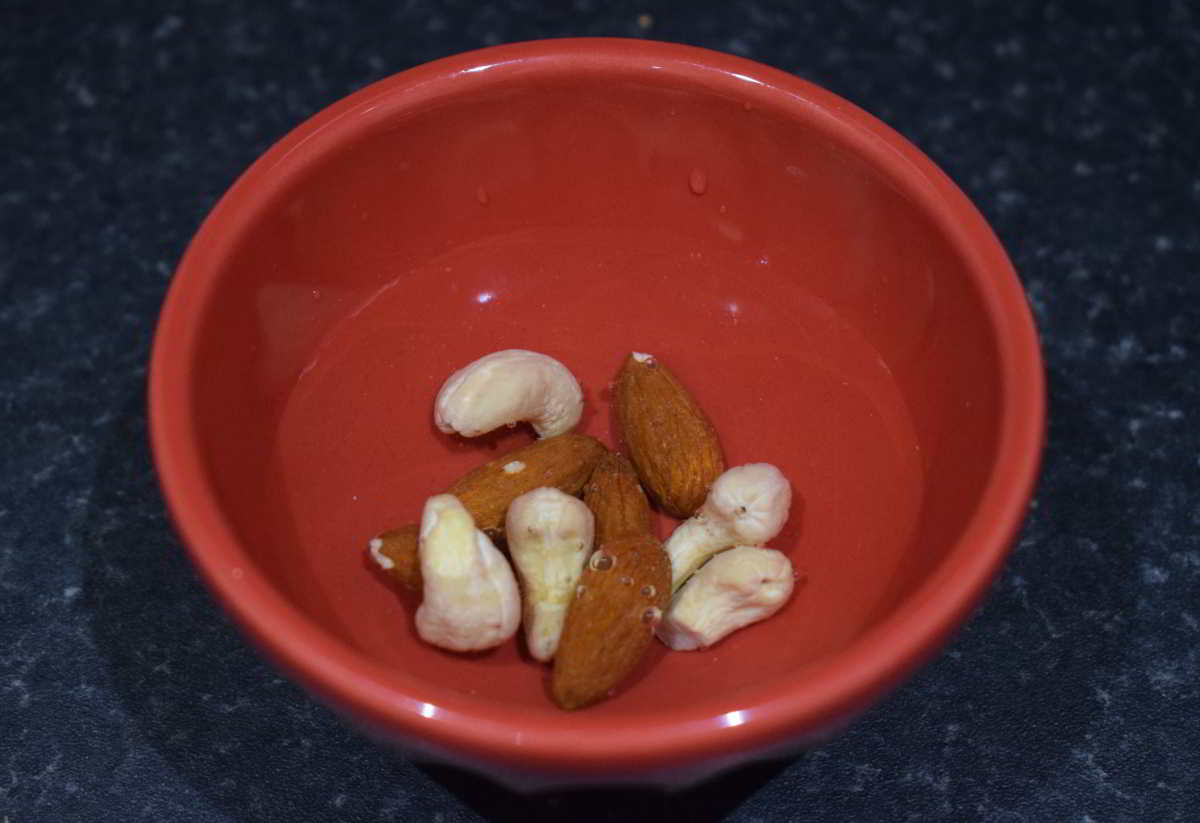
- Take a jar of a grinder and transfer cashew and almonds into it. Add 2 tablespoons of water and close the lid of the jar. Pulse it to a smooth paste. Keep the paste aside.
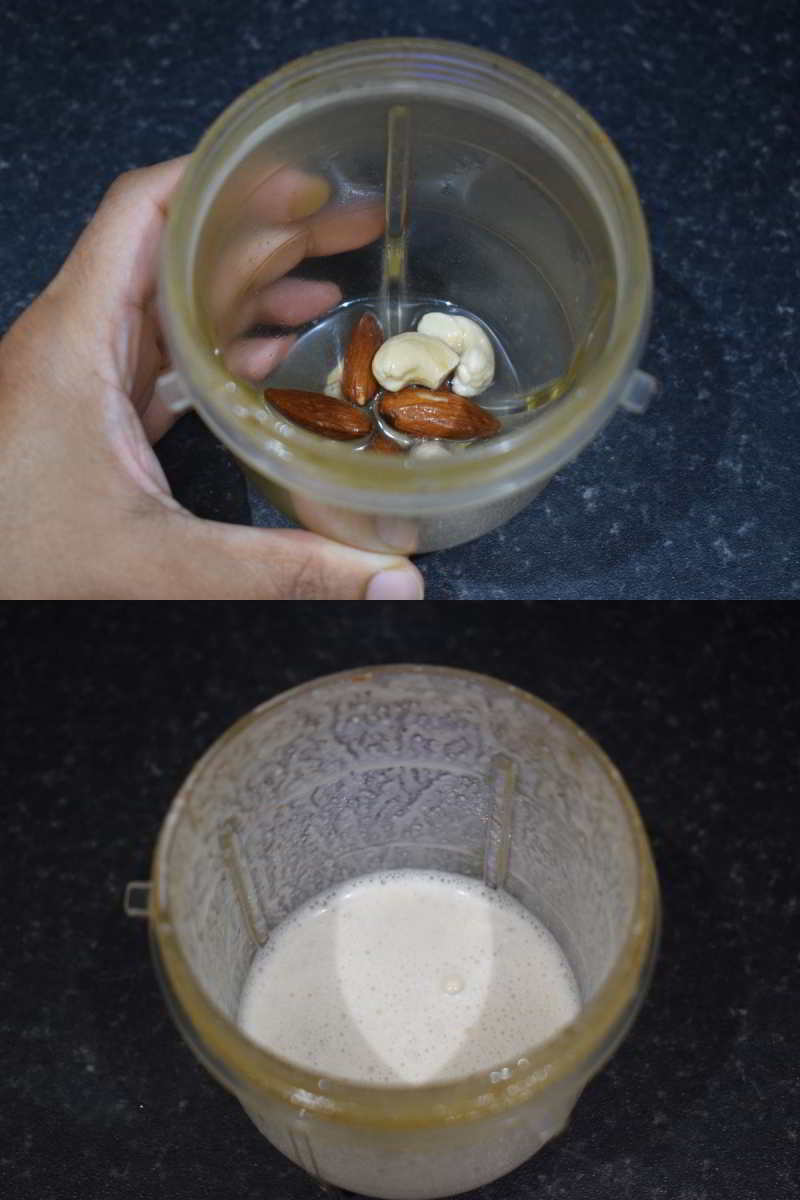
- Make a fresh paste of ginger and garlic. Add 2 inches ginger cubes and 10-12 peeled garlic cloves into a jar of a grinder and add 1 tablespoon of water if required. Close the lid of the jar and pulse it to a smooth paste and keep it aside.
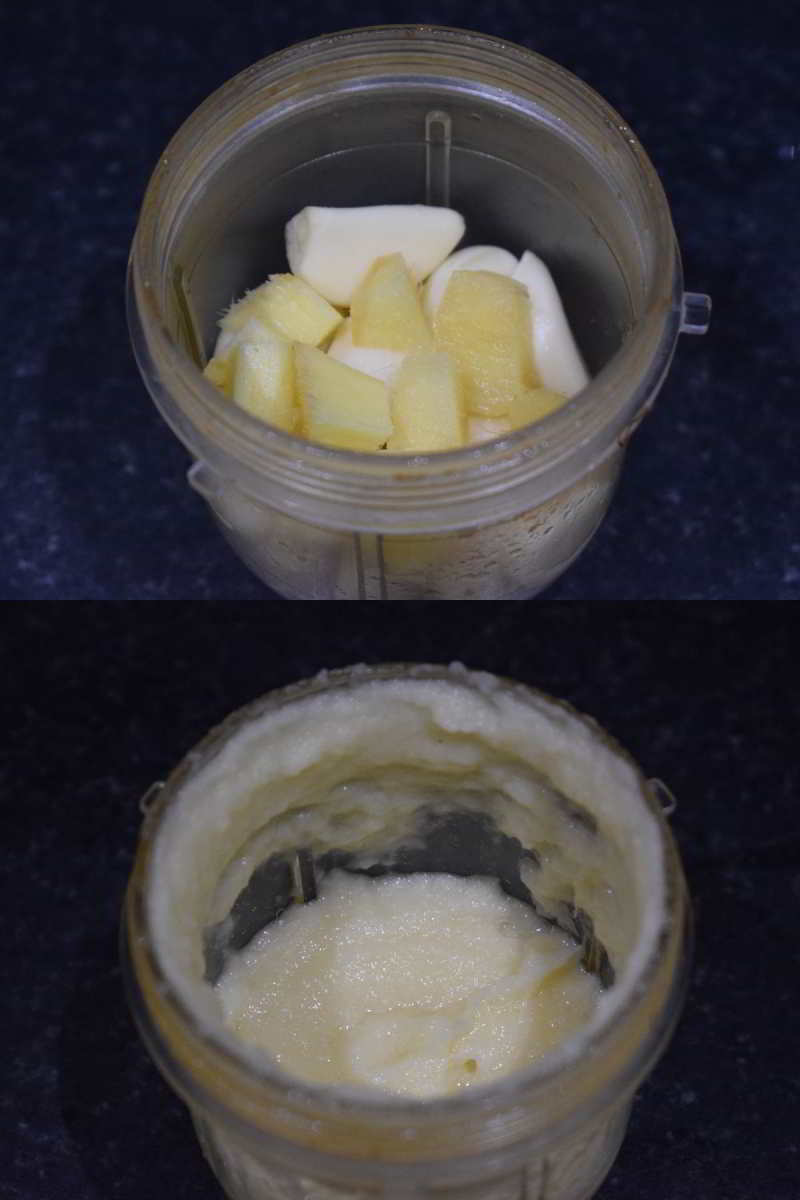
- Next, wash 1 kg mutton pieces nicely and keep them aside. Strain the water completely.
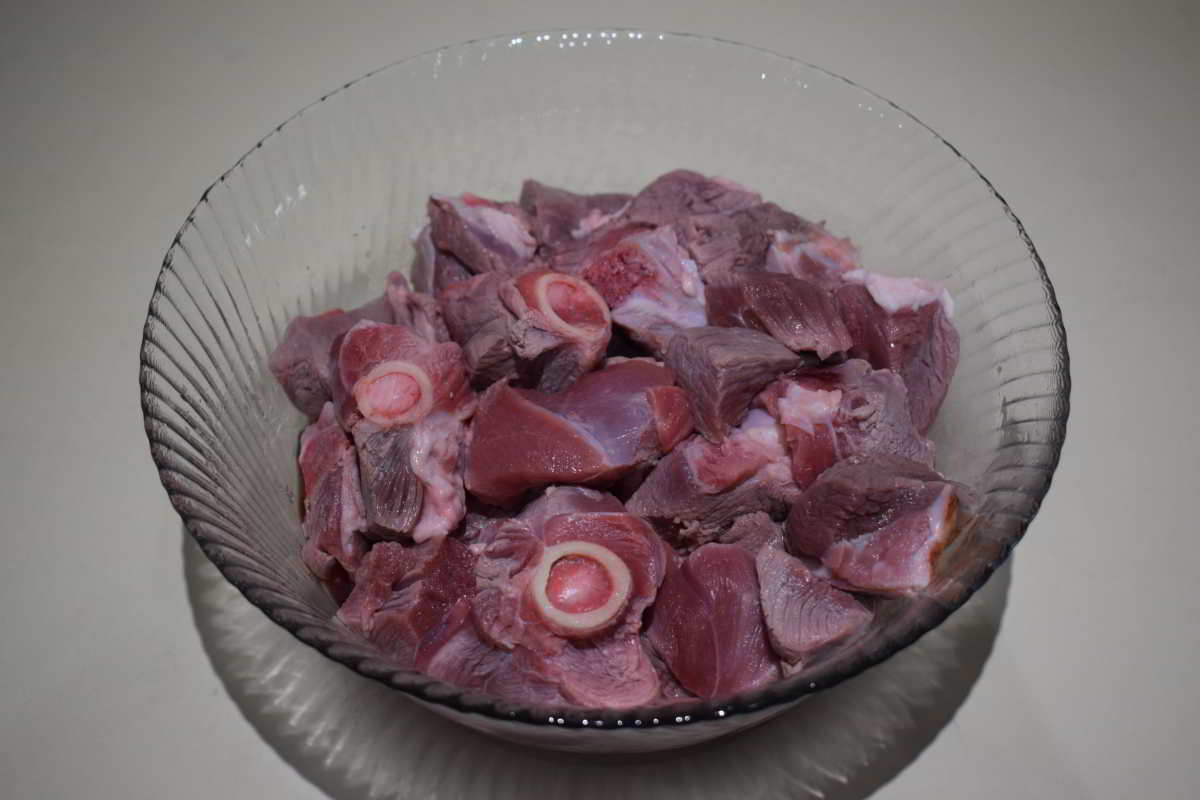
- Now, in the same pan, where beresta is prepared or you can transfer the oil to a separate pan. Add ¼ cup ghee aka clarified butter and put it on medium flame.
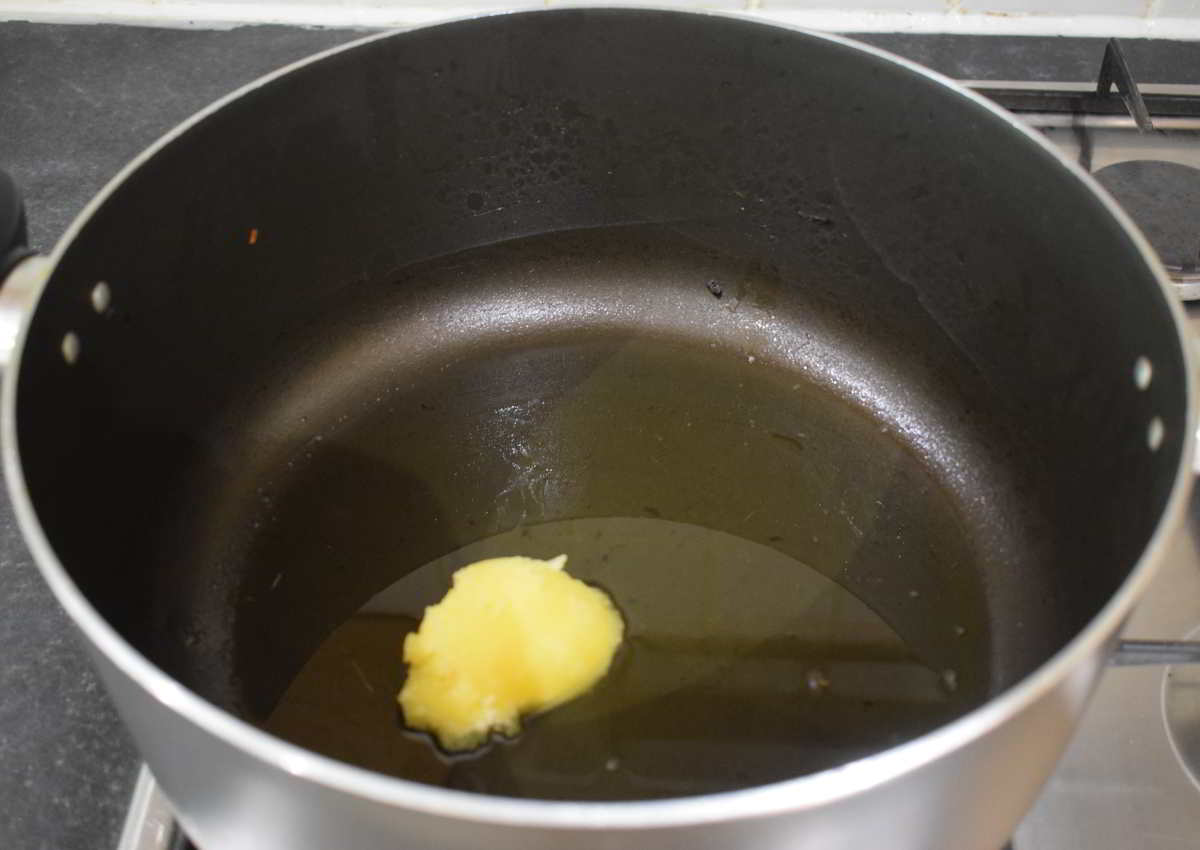
- Once the ghee melts, add the whole spices – 3 inches cinnamon stick, 7-8 green cardamoms, 1 black cardamom, 10 cloves, 1 star anise, 3 bay leaves and allow them to crackle.
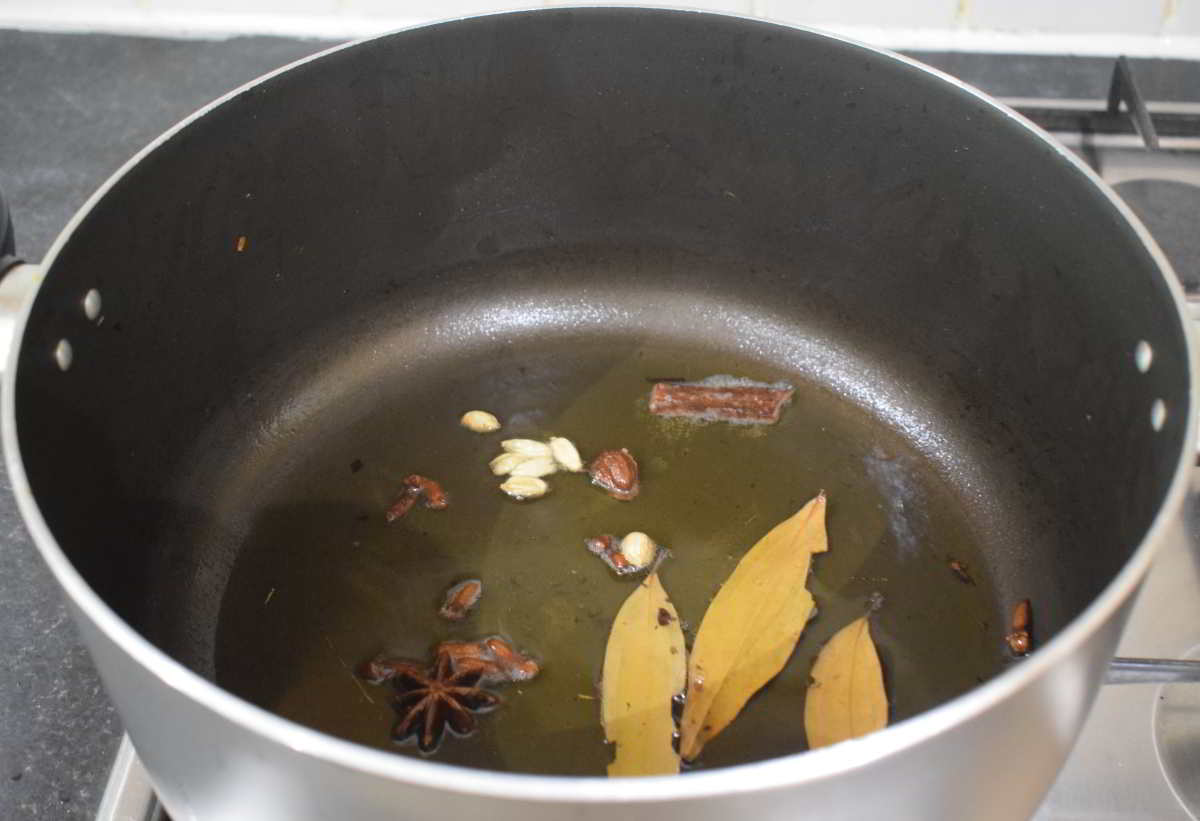
- Add the washed mutton pieces into the pan and give a nice stir. Fry the mutton pieces over medium-high flame for 7-8 minutes until the colour of the mutton pieces changes. Stir it continuously for even cooking.
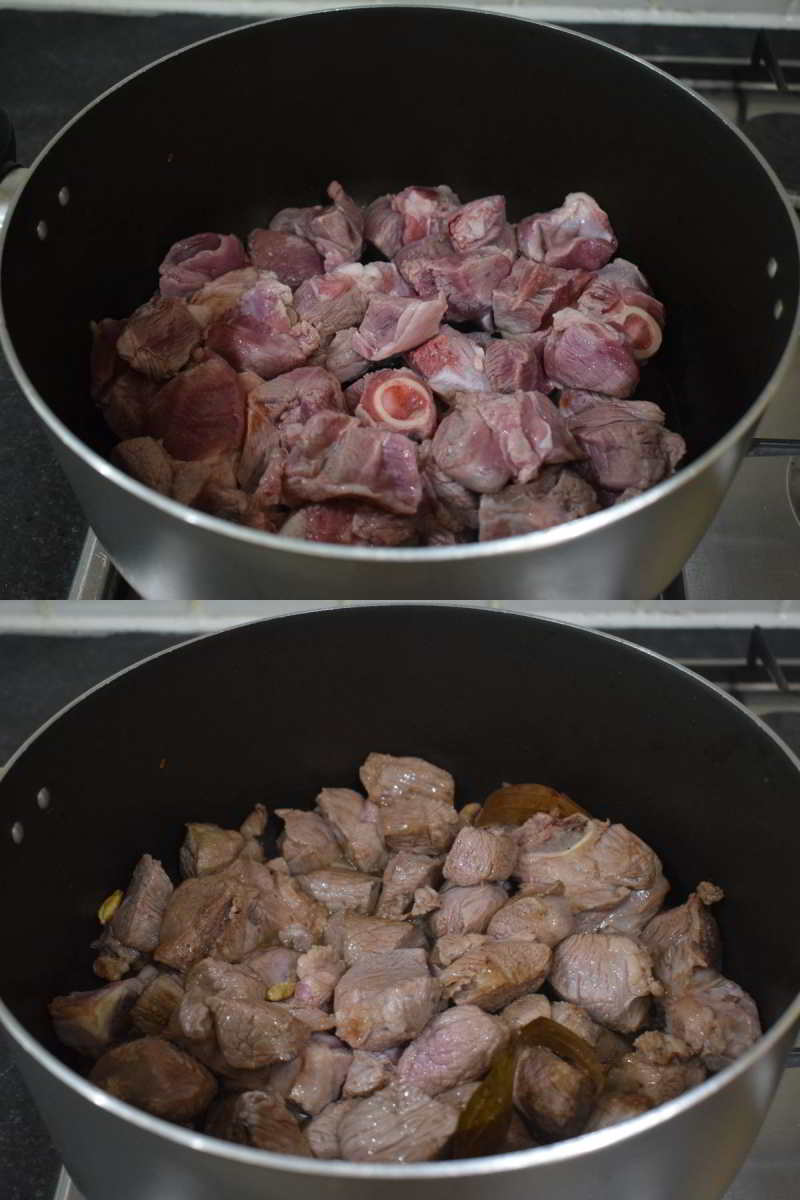
- Add the freshly ground ginger-garlic paste into the pan and mix it thoroughly. Turn the flame to medium-low and cook it for 12-15 minutes. Stir it frequently at regular intervals.
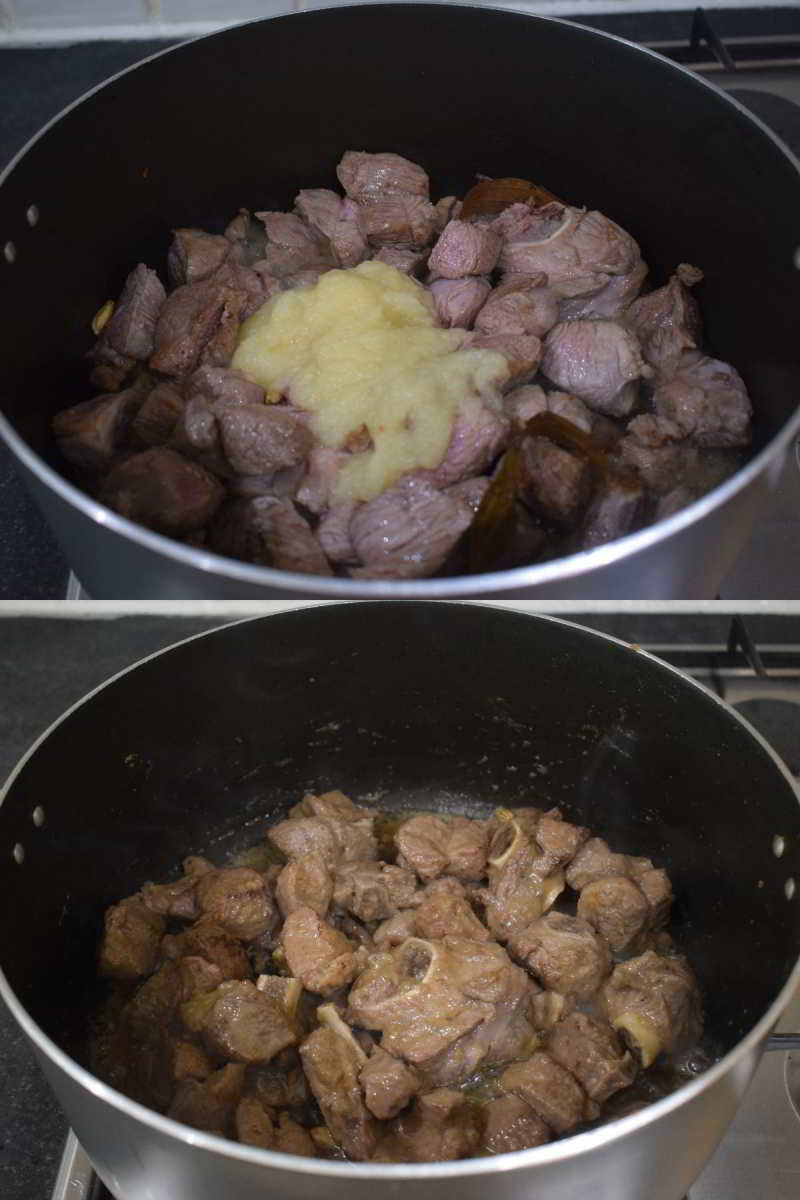
- Add 1 cup room temperature yogurt, 1 teaspoon red chilli powder, salt into the pan and mix all the ingredients well. Cook it over medium flame for around 12-15 minutes until the oil gets separated. Stir it every 5 minutes intervals.
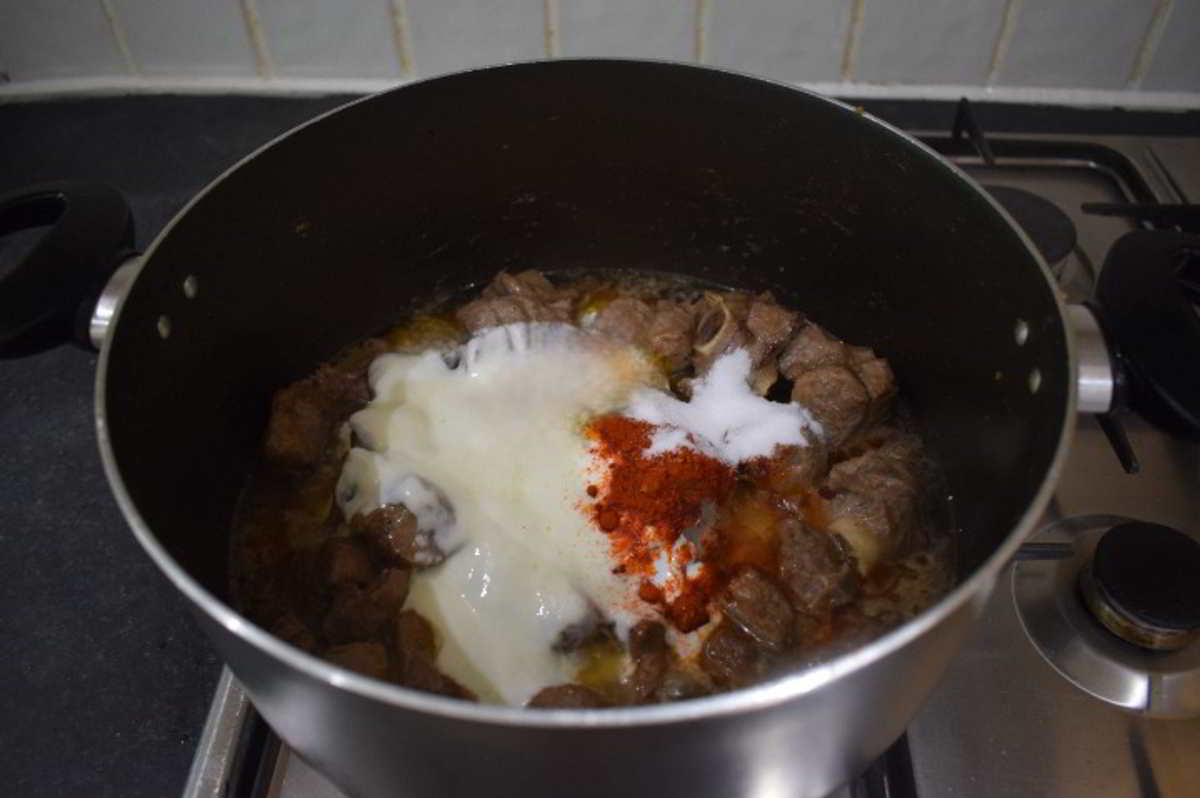
- Add 4 cups of water and cook it over a high flame until the water starts boiling. Then turn the flame to low and cover the pan. Cook it for 60-90 minutes until the mutton pieces get tender. The cooking time may vary due to the quality or quantity of mutton. Stir in between every 15-minute interval.
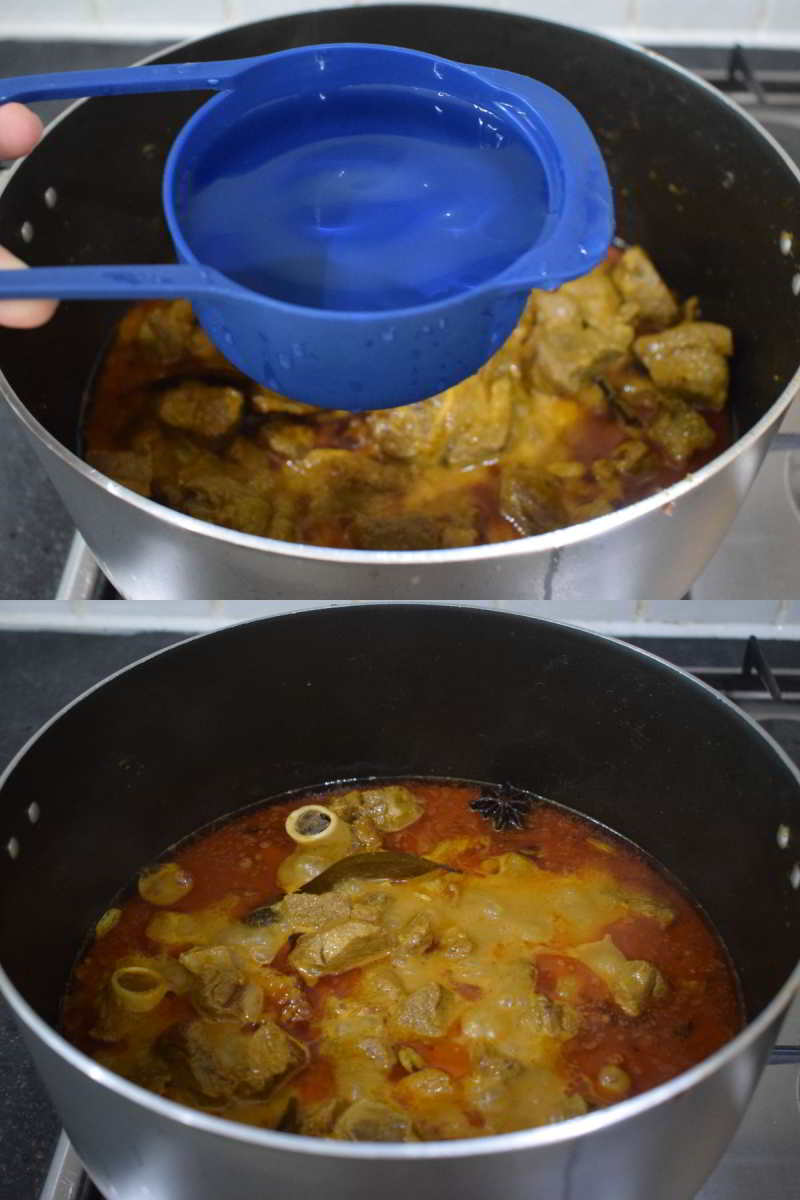
- Add the grind beresta aka fried onion, cashew-almond paste and freshly ground spice mix, one by one into the pan and mix it well. Cover the pan and cook it over low flame for another 10-15 minutes.

- Take off the lid of the pan and check the consistency of the gravy. If you want more gravy then add ⅓-½ cup of water and turn the flame high to allow it to boil. Check the salt of the gravy and add more if required.
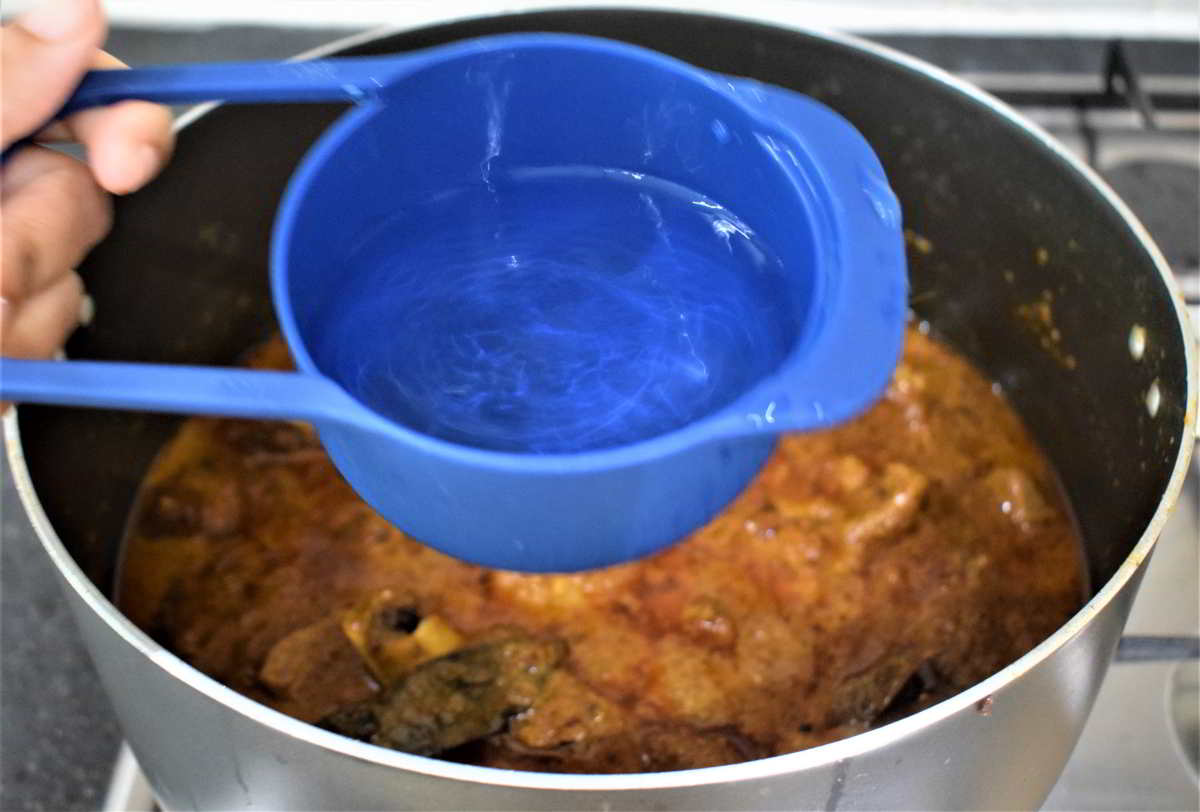
- At the final stage, add 1½ tablespoons kewra water and saffron-soaked milk, one by one into the pan and mix it well.

- Cook it on high flame for 10-15 seconds and then switch off the flame. Now the Mutton Korma is ready to serve.

Serving Instruction
Transfer the Mutton Korma into a serving bowl or on a serving plate. Always serve the Lamb Korma hot or warm to enjoy its best taste. Pair up the succulent mutton curry with any of your favourite flat bread like naan, paratha or with pulao, plain rice and enjoy the incredible delight.
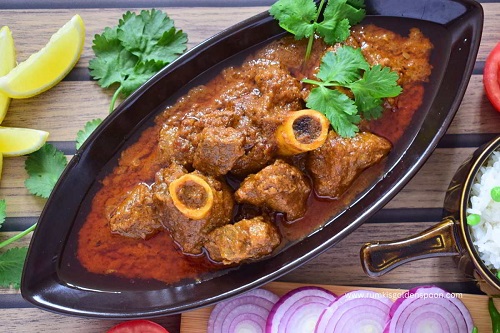
Ingredients
1 cup = 250 ml
To prepare the spice mix
- 5 green Cardamoms (choti Elaichi)
- 1 black Cardamom (badi Elaichi)
- 2 inches Cinnamon stick (Dalchini)
- 4 Cloves (Laung)
- ½ Mace (Javitri)
- ¼ Nutmegs (Jaiphal)
- 1 dry Kashmiri red Chilli (Kashmiri Lal mirch)
- ½ teaspoon Black peppercorns (Kali mirch)
For the cashew-almond paste
- 5 Cashew nuts
- 5 Almonds
- 2 tablespoons Water
For the saffron milk
- 1 pinch Saffron (Kesar)
- 2 tablespoons warm Milk
For the beresta or barista
- 5 large Onions, thin sliced
- ¼ cup Vegetable oil or any other odourless Oil
For the curry
- 1 kg Mutton, bone in curry cut
- 1 cup fresh and thick Yogurt
- 3 tablespoon Garlic paste or 10-12 large garlic cloves
- 2 tablespoon Ginger paste or 2 inches Ginger
- 3 Bay leaves (Tejpatta)
- 7-8 Green Cardamoms (choti Elaichi)
- 1 Black cardamom (badi Elaichi)
- 3 inches Cinnamon stick (Dalchini)
- 10 Cloves (Laung)
- 1 Star Anise (Chakra Phool)
- 1 teaspoon Kashmiri red chilli powder
- 1½ tablespoons Kewra water
- 4 cups Water for gravy (adjust according to your desired consistency)
- Salt to taste
- ¼ cup Ghee aka clarified butter for cooking
Instructions
For the spice mix
- Put a dry pan on flame and allow it to become completely dry. Add the whole spices - 1 black cardamom, 5 green cardamom, 4 cloves, 2 inches cinnamon sticks, ½ teaspoon black pepper, 1 dried Kashmiri red chilli, ½ mace and ¼th nutmeg, one by one into the pan. Dry roast them over medium flame for 2-3 minutes until a nice aroma comes out of the spices. Then transfer them to a separate dry plate and allow them to cool down completely before grinding.
- Take the whole spices into a small jar of a grinder and pulse it to a smooth dust-like texture. Note: You can prepare the masala in advance and store it in an airtight container in a cool and dry place away from sunlight for 3-4 months.
For the beresta or barista
- Thin slice 4 large onions evenly and separate them with hands.
- Now, put a pan on flame and add ¼ cup oil to it. Once the oil is hot, add onion slices and fry it over medium flame till crispy and golden in colour. Then strain the beresta properly and transfer them to a tissue-lined separate plate. Don’t overcrowd the pan during the time of preparing beresta and stir it continuously or else it will not get fried evenly.
- Allow the beresta to cool down completely and then transfer it to a jar of a grinder. Pulse it for a minute and keep it aside.
For the curry
- Take 2 tablespoons of warm milk into a bowl and add a pinch of saffron to it. Soak the saffron in the milk at least for 20 minutes so that it can release flavour and colour to the milk.
- Take a bowl and add 5 cashew nuts and 5 almonds into it. Add hot water to it and allow it to soak for 10 minutes.
- Take a jar of a grinder and transfer cashew and almonds into it. Add 2 tablespoons of water and close the lid of the jar. Pulse it to a smooth paste. Keep the paste aside.
- Make a fresh paste of ginger and garlic. Add 2 inches ginger cubes and 10-12 peeled garlic cloves into a jar of a grinder and add 1 tablespoon of water if required. Close the lid of the jar and pulse it to a smooth paste and keep it aside.
- Next, wash 1 kg mutton pieces nicely and keep them aside. Strain the water completely.
- Now, in the same pan, where beresta is prepared or you can transfer the oil to a separate pan. Add ¼ cup ghee aka clarified butter and put it on medium flame.
- Once the ghee melts, add the whole spices - 3 inches cinnamon stick, 7-8 green cardamoms, 1 black cardamom, 10 cloves, 1 star anise, 3 bay leaves and allow them to crackle.
- Add the washed mutton pieces into the pan and give a nice stir. Fry the mutton pieces over medium-high flame for 7-8 minutes until the colour of the mutton pieces changes. Stir it continuously for even cooking.
- Add the freshly ground ginger-garlic paste into the pan and mix it thoroughly. Turn the flame to medium-low and cook it for 12-15 minutes. Stir it frequently at regular intervals.
- Add 1 cup room temperature yogurt, 1 teaspoon red chilli powder, salt into the pan and mix all the ingredients well. Cook it over medium flame for around 12-15 minutes until the oil gets separated. Stir it every 5 minutes intervals.
- Add 4 cups of water and cook it over a high flame until the water starts boiling. Then turn the flame to low and cover the pan. Cook it for 60-90 minutes until the mutton pieces get tender. The cooking time may vary due to the quality or quantity of mutton. Stir in between every 15-minute interval.
- Add the grind beresta aka fried onion, cashew-almond paste and freshly ground spice mix, one by one into the pan and mix it well. Cover the pan and cook it over low flame for another 10-15 minutes.
- Take off the lid of the pan and check the consistency of the gravy. If you want more gravy then add ⅓-½ cup of water and turn the flame high to allow it to boil. Check the salt of the gravy and add more if required.
- At the final stage, add 1½ tablespoons kewra water and saffron-soaked milk, one by one into the pan and mix it well.
- Cook it on high flame for 10-15 seconds and then switch off the flame. Now the Mutton Korma is ready to serve.

